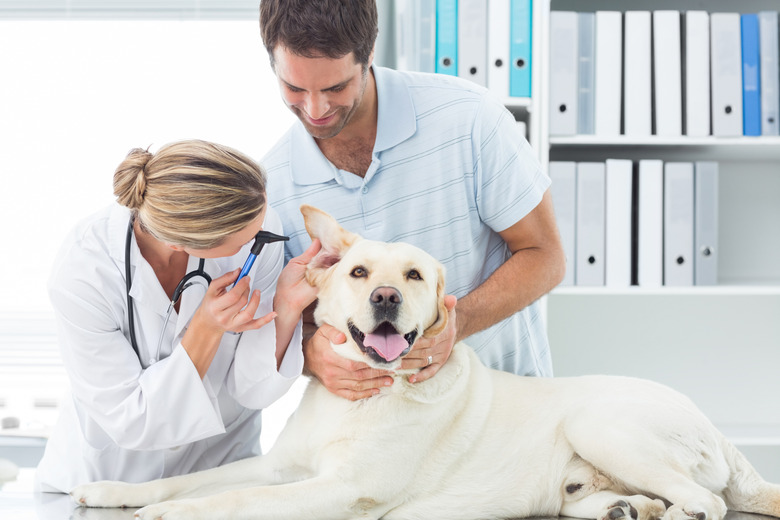How To Cure Skin Yeast Infection In Dogs
Dogs can contract skin yeast infections anywhere on their bodies, though feet and ears are the most common spots. This fungal infection develops due to an imbalanced immune system, oily skin or skin allergies. Abnormal flora levels can be exacerbated by hot weather, sugary diets and various medications, such as antibiotics. Though not contagious, skin yeast infections can be irritating for your dog. Consult your vet once signs and symptoms appear.
Skin Yeast Infection Symptoms
Skin Yeast Infection Symptoms
Dogs with skin yeast infections have a prominent "yeasty" or musty smell. If their ears and feet are infected, they'll continually scratch, lick and paw the itchy parts and may walk in circles or shake their heads. Dogs will full-body skin yeast infections will have red, irritated skin and generally will be miserable, itchy and uncomfortable. Your vet can diagnose the problem through skin cultures or by examining skin cells under a microscope. When you make your first vet visit, tell him about any medications your dog is on and bring a list of what your dog eats. Foods or treats containing honey and high-fructose corn syrup can be a skin yeast culprit.
Treatment Options
Treatment Options
Your vet will recommend treatment options based on the severity of the infection and the underlying cause contributing to the problem. For example, a change in diet may be required to reduce yeast-building sugars in the system. Oral medications such as terbinafine or ketoconazole may be prescribed to control itching and reduce yeast levels. Typically, your vet will recommend a topical anti-fungal shampoo or cream containing benzoyl peroxide or chlorhexidine to reduce the yeast buildup on the skin by removing excess oil. You may be advised to disinfect the skin with an astringent such as witch hazel between applications to avoid a buildup of dead yeast layers, which can delay the recovery process.
Complications of Yeast Infections
Complications of Yeast Infections
Your dog can develop a secondary infection if he scratches or licks irritated skin into open sores or hot spots. This typically requires antibiotic treatment; your pup may need to wear an Elizabethan collar to prevent further mouth-to-skin contact during the treatment and recovery phases. Yeast infections of the ear can lead to balance problems and loss of hearing if left untreated. Frequently occurring skin yeast infections can be a sign of allergies or a compromised immune system, which should be investigated by your vet.
Yeast Infection Prevention
Yeast Infection Prevention
Some dogs are prone to yeast infections and may benefit from regular disinfecting washes or soaks, depending on the location of the infection. For example, dogs with yeasty feet can be treated by placing paws in a shallow container containing water, hydrogen peroxide and white vinegar. Dogs with yeasty ears can be swabbed down with witch hazel as often as needed to remove wax and prevent future yeast infections. Dogs who experience recurring full-body skin infections can be treated with vet-approved antifungal body washes to reduce the potential for outbreaks.
